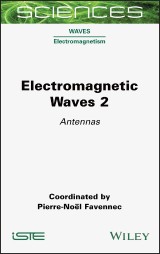Details

Electromagnetic Waves 2
Antennas1. Aufl.
|
139,99 € |
|
| Verlag: | Wiley |
| Format: | |
| Veröffentl.: | 05.03.2021 |
| ISBN/EAN: | 9781119818458 |
| Sprache: | englisch |
| Anzahl Seiten: | 272 |
DRM-geschütztes eBook, Sie benötigen z.B. Adobe Digital Editions und eine Adobe ID zum Lesen.
Beschreibungen
<p><i>Electromagnetic Waves 2</i> examines antennas in the field of radio waves. It analyzes the conditions of use and the parameters that are necessary in order to create an effective antenna.</p> <p>This book presents antennas’ definitions, regulations and fundamental equations, and describes the various forms of antennas that can be used in radio: horns, waveguides, coaxial cables, printed and miniature antennas. It presents the characterization methods and the link budgets as well as the digital methods that make the fine calculation of radio antennas possible.</p> <p><i>Electromagnetic Waves 2</i> is a collaborative work, completed only with the invaluable contributions of Ibrahima Sakho, Hervé Sizun and JeanPierre Blot, not to mention the editor, Pierre-Noël Favennec. Aimed at students and engineers, this book provides essential theoretical support for the design and deployment of wireless radio and optical communication systems.</p>
<p>Preface ix</p> <p><b>Chapter 1. General Information on Antennas </b><b>1<br /></b><i>Jean-Pierre BLOT</i></p> <p>1.1. Definition, context, and regulation 1</p> <p>1.1.1. The International Union of Telecommunications and Radio communications (ITU-R) 9</p> <p>1.1.2. Frequency bands: uses and classification (see also appendices 3 and 5) 10</p> <p>1.1.3. Review of some technologies by frequency bands (see also appendices 3 and 5) 12</p> <p>1.2. Propagation and radiation 19</p> <p>1.3. Antenna and sensor 20</p> <p>1.3.1. Antenna operating in transmission and reception 23</p> <p>1.4. Theorems and important principles of electromagnetism 27</p> <p>1.4.1. Lorentz reciprocity theorem 27</p> <p>1.4.2. Huygens-Fresnel principle 28</p> <p>1.4.3. Uniqueness theorem 30</p> <p>1.4.4. Image theory 30</p> <p>1.4.5. Superposition principle 30</p> <p><b>Chapter 2. Fundamental Equations Used in Antenna Design </b><b>31<br /></b><i>Jean-Pierre BLOT</i></p> <p>2.1. Formulations of Maxwell’s equations to calculate the radiation of electromagnetic sources 31</p> <p>2.1.1. Maxwell’s equations 32</p> <p>2.1.2. Material media 34</p> <p>2.1.3. Vectors <i>D</i> and <i>H</i> 36</p> <p>2.1.4. Source currents and induced currents 42</p> <p>2.1.5. Integral form of Maxwell’s equation 44</p> <p>2.2. Boundary conditions between two media 44</p> <p>2.3. Vector potential 47</p> <p>2.3.1. Propagation equations for the vector potential 50</p> <p>2.3.2. Propagation equations for the scalar potential 52</p> <p>2.3.3. Vector and scalar potentials in the harmonic regime 53</p> <p>2.4. Propagation equation for fields <i>E</i> and <i>H </i>54</p> <p>2.5. Solving the Helmholtz equations for the vector and scalar potentials 55</p> <p>2.5.1. Orthogonality of distance fields zone and radiated power; radiation pattern 57</p> <p>2.6. Harmonic form of Maxwell’s equations 61</p> <p>2.7. Physical interpretation of the Poynting theorem 61</p> <p>2.7.1. Poynting vector in the time domain 61</p> <p>2.7.2. Poynting vector in the frequency domain 64</p> <p>2.8. Polarized wave 65</p> <p>2.8.1. Definition of a plane wave 65</p> <p>2.8.2. Polarizations of a wave 66</p> <p>2.9. Calculating the electromagnetic field radiated by an antenna 72</p> <p>2.9.1. Expanded discussion of the EFIE and MFIE formulae 72</p> <p>2.9.2. Calculations for an elementary dipole 73</p> <p>2.10. Aperture antenna 76</p> <p>2.10.1. Wireless radiation of apertures 76</p> <p>2.10.2. Identification of the different zones 80</p> <p><b>Chapter 3. Different Antenna Technologies </b><b>85<br /></b><i>Jean-Pierre BLOT</i></p> <p>3.1. Horns 85</p> <p>3.2. Coaxial cables and input guides in antennas 87</p> <p>3.2.1. Coaxial cables 89</p> <p>3.2.2. Waveguides 91</p> <p>3.3. Supply to antennas, reference access, impedance matching and balun 105</p> <p>3.3.1. Supply lines 105</p> <p>3.3.2. Reference access 105</p> <p>3.3.3. Matching networks 107</p> <p>3.3.4. Baluns and symmetrizers 109</p> <p>3.4. Reflector antennas 110</p> <p>3.5. Printed antennas 115</p> <p>3.5.1. Low-bandwidth structures 116</p> <p>3.5.2. High-bandwidth structures, or frequency-independent structures 121</p> <p>3.6. Reference wire antennas 122</p> <p>3.7. Quality factor and frequency bandwidth 123</p> <p>3.7.1. Quality factor 123</p> <p>3.7.2. Frequency bandwidth 124</p> <p>3.8. Miniaturization 125</p> <p><b>Chapter 4. Characteristic Parameters of an Antenna </b><b>131<br /></b><i>Jean-Pierre BLOT</i></p> <p>4.1. Characteristic parameters of an antenna 131</p> <p>4.1.1. Capture surfaces or equivalent surfaces on an antenna 132</p> <p>4.1.2. Directivity and gain 133</p> <p>4.1.3. Relation between gain, directivity and radiation pattern 135</p> <p>4.1.4. Effective height or effective length 136</p> <p>4.2. Link budget 138</p> <p>4.3. Power and noise temperature 140</p> <p>4.3.1. Noise temperature received by an antenna 143</p> <p>4.3.2. Link budget and Friis formula 144</p> <p>4.4. Quality factor Q = G/T 145</p> <p><b>Chapter 5. Digital Methods </b><b>149<br /></b><i>Jean-Pierre BLOT</i></p> <p>5.1. Introduction to digital methods 149</p> <p>5.1.1. Overview of the main digital methods 149</p> <p>5.1.2. Hybridization of digital methods 155</p> <p>5.1.3. Low-frequency methods 155</p> <p>5.1.4. Introduction to high-frequency methods 189</p> <p>5.2. General remarks on EMC methods 195</p> <p>Appendix 1 197</p> <p>Appendix 2 201</p> <p>Appendix 3 219</p> <p>Appendix 4 227</p> <p>Appendix 5 231</p> <p>List of Acronyms and Constants 233</p> <p>References 235</p> <p>List of Authors 243</p> <p>Index 245</p>
<p><b>Pierre-Noel Favennec</b> is a Doctor of Science, former researcher at France Telecom and former consultant at the Institut Telecom. He is now the Chairman of ArmorScience.
Diese Produkte könnten Sie auch interessieren:

Ermittlung der Wicklungstemperatur einer neunphasigen Synchronmaschine mit COMSOL

von: Yvonne Schröder

18,99 €
















